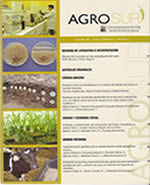LAMB GROWTH UNDER DIFFERENT MANAGEMENTS AT WEANING: PADDOCK CHANGE, SHEARING AND DEWORMING
Main Article Content
Abstract
The objective of this work was to test the effect of different managements at weaning on subsequent lamb growth. The study was conducted at Comuna Río Verde, Magallanes, in Chilean Western Patagonia. Three managements were studied in a factorial arrangement to obtain 8 treatments applied to 227 male lambs weaned in January 18th (initial mean weight 27.5±1.66 kg). Factors and levels were: change of paddock (immigrants, I) or staying in original paddock (residents, R), deworming (D) or not (P) and shearing (E) or not (V). The resulting treatments were: RED (n=28), REP (n=28), RVD (n=28), RVP (n=30), IED (n=28), IEP (n=28), IVD (n=29) e IVP (n=28). Lambs were weighed at the beginning and then on February 21st (first period, P1) and April 19th (second period, P2) at the end of the trial. The lambs were slaughtered two days later and their carcasses were weighed. Only deworming had a significant positive effect (P<0.05) on weight gain for P1 (D: 9.63 kg; P: 9.08 kg) and a positive tendency (P=0.07) for the total period (15.3 vs. 14.41 kg). Average live weight gain for P1, P2 and total period was 292.0, 96.3 and 166.7 g/d, respectively, with interactions between treatments, especially for shearing x residence. IVD and RID lambs were the best performers, while RVP and IEP treatments had lower weight gain. Shearing was associated to a higher number of lambs killed by predators (foxes). The treatments had no effect on carcass weight, which averaged 16.7 kg.

